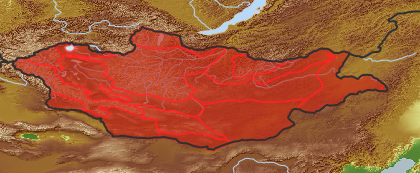| Class: | angiosperms |
| Order: | Ranunculales |
| Family: | Ranunculaceae |
| Editor | S. Rilke, July 2010 |
| Name acc. to: | APGII |
| Herbar: | list records    |
| Description: | Flower parts often arranged in spirals; petaloid structures often bearing nectaries; with numerous stamens and carpells. |
| Comments: | The family showes a wide variation in flower structures |
| open map in a new window |  |
| genus: 22 |
| species: 121 |
| Habit (i)general appearance of a plant | |
| Growth form: (i)Herb, shrub, tree or climber. | herb (i)Herbaceous, erect plant, up to 2m high, mostly with a leafy shoot; if perennial, shoots die to the ground each season, shoots are not woody
example: Artemisia pectinata 
|
| Parasite status: (i)Is the plant a half- or full parasite? | no parasite/saprophyte (i)Plant fully autonomous, leaves with chlorophyll
example: Most plants, Ranunculus
|
| Leaf (i)expanded, usually photosynthetic organ of a plant (including phylloclades) | |
| Leaf development: (i)Structure and development of leaves. | with green leaves (i)Plant with green leaves
|
| Stipule: (i)Leaflets at the base of the petiole, these are smaller and of different shape. | none (i)Without stipules
example: Euphorbia, Ericaceae s.l.
|
| Leaf veination: (i)Arrangement of the main veins of a leaf. | pinnate (i)One main vein, several side veins, sometimes inconspicuous
example: Cicerbita   
palmate (i)Several nearly equal main veins united at the point where the petiole inserts
example: Malva 
|
| Flower (i)reproductive portion of the plant, consisting of sepals, petals, stamens, and pistils | |
| Flower appearance and pollination: (i)General appearance of the flower. | attractive, animal-pollinated (i)attractive and coloured flowers, mostly large, attracting surely animals
example: Trollius, Rosa, Chamaerhodos
|
| Sepal fusion: (i)To which degree are the sepal leaves connected? Attention, this character applies only for flowers separated in sepals and petals, thus excluding most monocots. Be aware of the bracts (involucral leaves) of Asteraceae flowerheads, do not qualify these as sepals! | free (i)All leaves separate from each other
example: Geranium
|
| Petal / Tepal fusion: (i)To which degree are the petal leaves connected? Petals sympetalous. | free (i)all petal leaves separate from each other
example: Anthriscus
|
| Stamen number: (i)Attention: We ask for the reproductive organs of the flower dispersing pollen. Count only fully fertile stamens, not staminodia (e.g. Parnassia). | > 10 (i)
example: Nymphaea, Callianthemum, Rosa
|
| Stamen fusion: (i)To which degree are the stamens fused? Attention: Whereas the pollen sacs itself are often free., their stalks (filaments) may be fused. Here, we count them as fused if they are together over at least one thirth of their length. | free (i)Stamens with separate bases
example: Malus
|
| Carpel number: (i)Number of carpels (carpel: forming a simple pistil or part of a compound pistil, modified leaf). | > 5
|
| Carpel fusion: (i)To which degree are the carpels (modified leaf forming simple pistil or part of a compound pistil) fused. | free (i)Carpels entirely free
example: Geum, Aconitum
|
| Ovary position: (i)For entirely or partly fused carpels, describe their position in relation to the insertion point of perianth leaves (best done by doing a longitudinal section of a flower). | superior (hypogynous) (i)Base of carpels attached above insertion point of perianth leaves, carpels free or fused
example: Delphinium, Anemone    inherited by order Ranunculales: superior (hypogynous) inherited by order Ranunculales: superior (hypogynous)
|
| Sex: (i)Distribution of male and female organs among flowers, only most commonly cases. | bisexual, hermaphrodite (i)All or nearly all flowers of a plant with male and female parts
example: Haplophyllum, Chenopodium
|
| Fruit (i)the seed bearing organ, with or without adnate parts; a ripened ovary and any other structures which are attached and ripen with it. Aggregate fruits are handled like simple fruits for determination. | |
| Consistency: (i)Fleshy fruits or dry fruits, see dispersal adaptations for further classification. | dry (i)With a dry outer shell, no fleshy parts, but seed (embryo) could be edible
|
| Opening of fruit: (i)Mode of dehiscence at maturity to release seeds. | opening along dehiscent line (i)Opening along a preformed line
example: Vicia, Lathyrus: pods
opening / dehiscent (i)Dry? Fruits opening with different types
|
| Root / shoot below ground (i)plant part below ground (in most cases), including below ground shoots, without leaves | |
| Root type: (i)Organisation of the roots. | allorhizous (i)Plant with a conspicuous tap root, one larger tap root with side roots
example: Dicotyledonae  inherited by order Ranunculales: allorhizous inherited by order Ranunculales: allorhizous
|
| Runners: (i)Plant must be excavated; shoots, subterranean shoots connected by runners. | none (i)No runners or stolos visible
example: Dactylorhiza
long root suckers or rhizomes (i)Plants grow new shoots from roots or subterranean shoots, called rhizomes, these spacing stems apart
example: Hippophae, Artemisia sericea
stolons (i)Plants creep with above-ground shoots (stolons) which can root and establish new plants
example: Potentilla arenaria, P. anserina 
|
| Storage in below-ground structures: (i)Rhizomes or bulbs. | none (i)Plant with non-thickened roots, their maximum diameter does not exceed the diameter of the shoot base
example: Anabasis brevifolia
storage rhizomes (i)Horizontal, root like structures with scale leaves or their scars, these clearly thicker than the bases of above-ground shoots
example: Petasites, Iris
|